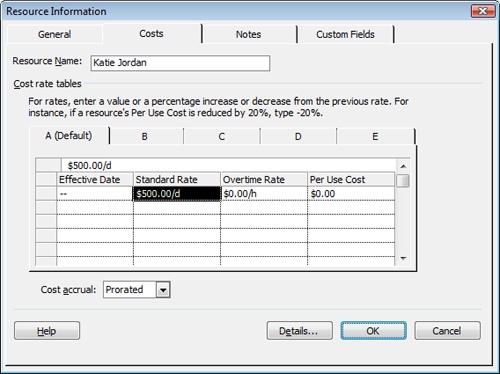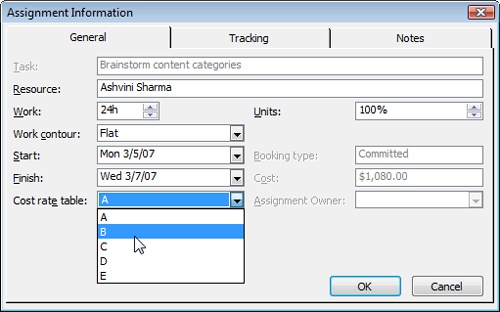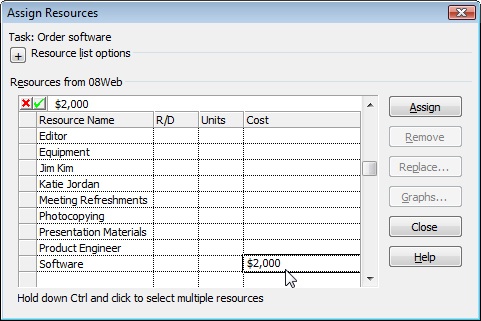The key to planning project costs is entering resource costs. Typically, the majority of your costs comes from resources carrying out their assignments. When you enter resource cost rates and assign resources to tasks, those resource cost rates are multiplied by the amount of work on assignments. The result is the cost of the assignment.
You can set costs for work resources as well as material resources. Cost rates might be variable, such as $40/hour, or $200/ton. Or they might be a fixed per-use cost, such as $300 per use.
You can also use cost resources, new in Microsoft Office Project 2007, to assign frequently used cost items—for example, facility rental, permit fees, or travel costs—to specific tasks and then specify the amount for that cost resource on that assigned task.
You can set pay rates for work resources: people and equipment. When these resources are assigned to tasks, Microsoft Project multiplies the pay rates by the amount of assigned work to estimate the planned cost for the assignment. You can also set per-use costs for work resources. If a resource has different costs for different types of assignments or during different periods of time, you can enter multiple costs for one resource.
Note
You can enter cost information for resources at the same time you add resources to the project. Simply complete all the fields in the Resource Sheet at the same time.
To set pay rates for work resources, follow these steps:
Click View, Resource Sheet.
If the Entry table is not already applied to the Resource Sheet, click View, Table, Entry.
Make sure that the work resource is set up.
Work resources are designated with Work selected in the Type field.
Note
For more information about setting up work resources, see the section titled Adding Work Resources to the Project in Chapter 6.
In the Std. Rate field for the first work resource, enter the resource’s standard pay rate, for example, $30/hour, or $400/day.
If the resource is eligible for overtime, enter the resource’s overtime pay rate in the Ovt. Rate field (see Figure 8-1).
Note
For more information about setting up enterprise resource information, see the section titled Creating the Enterprise Resource Pool in Chapter 21.
Some work resources incur a cost each time you use them. This per-use cost might be instead of or in addition to a cost rate and is often associated with equipment. It’s a set, one-time fee for the use of the resource. For example, rental equipment might have a delivery or setup charge every time it’s used, in addition to its day rate.
Per-use costs never depend on the amount of work to be done. They’re simply one-time costs that are incurred each time the resource is used.
To specify a per-use cost, follow these steps:
To set resource costs for consumable materials, follow these steps:
Be sure that the Entry table is applied to the Resource Sheet. If it is not, click View, Table, Entry.
Make sure the material resource is set up in your Resource Sheet.
Material resources are designated with Material selected in the Type field. Each material resource should also have a unit of measurement—such as yards, tons, or feet—in the Material Label field.
Note
For more information about setting up material resources, see the section titled Adding Material Resources to the Project in Chapter 6.
In the Std. Rate field for the material resource, enter the cost per unit.
For example, if you have a material resource that is measured in tons, and each ton of this material costs $300, enter $300 in the Std. Rate field.
If there’s a per-use cost for the material, such as a setup fee or equipment rental fee associated with using the material, enter it in the Cost/Use field.
Suppose that you know that certain work resources will get a 5 percent raise on September 1. Maybe the contract for an equipment resource stipulates a discount for the first month of use and then the cost returns to normal for the second month and beyond. Or perhaps a consultant has one rate for one type of work and another rate for another type of work. You can specify different costs at different times by using the cost rate tables. To specify different costs, follow these steps:
In the Resource Sheet, click the work or material resource for which you want to specify multiple cost rates.
On the Standard toolbar, click Resource Information.
In the Resource Information dialog box, click the Costs tab (see Figure 8-2).
On the A (Default) tab, you see the standard rate, overtime rate, and per-use cost you might have already entered in the Resource Sheet.
To specify a change in rate after a certain period of time, click in the next blank Effective Date field and enter the date the change is to take effect. Enter the cost changes as applicable in the Standard Rate, Overtime Rate, and Per Use Cost fields (see Figure 8-3).
To specify different costs based on different types of activities, enter the different costs in a different tab, such as B or C.
Click the B tab, for example, and enter the standard rate, overtime rate, and peruse cost for the other activity as applicable. When you assign this resource to a task that uses the different rates, you can specify them with the assignment.
Note
If a percentage rate change goes into effect on a certain date, you can have Microsoft Project calculate the new rate for you. Enter the date in the Effective Date field. Then, in the Standard Rate, Overtime Rate, or Per Use Cost fields, enter the percentage change, for example, +10% or -15%. The actual rate representing that change is immediately calculated and entered in the field.
Cost Rate Table A for resources is applied to the resource’s assignments by default and is what shows on the Resource Sheet. If you define a different cost rate table for another category of work, you can specify which cost rate table is to be used at the assignment level. To do this, follow these steps:
In a task view such as the Gantt Chart view, use the Assign Resources dialog box to assign the resource to the task.
Click View, Task Usage or View, Resource Usage to switch to an assignment view.
Click the assignment that needs a different cost rate table applied and then click Assignment Information on the Standard toolbar.
If necessary, click the General or Tracking tab.
In the Cost Rate Table list, click the cost rate table you want to apply to this assignment (see Figure 8-4).
There is no way to enter a description for the different cost rate tables to explain what each one is to be used for. Because of this, it’s a good idea to enter a resource note for any resource that uses multiple cost rate tables. Simply click the Notes tab in the Resource Information dialog box and enter the note.
Cost accrual indicates the point in time when costs are incurred, or charged. You can have costs incurred at the beginning of the assignment or at the end of the assignment. Or you can have the costs prorated across the time span of the assignment, which is the default method. Specifying the cost accrual method is important for budget cash flow planning.
To specify the cost accrual method, follow these steps:
Be sure that the Entry table is applied to the Resource Sheet. If it is not, click View, Table, Entry.
In the Accrue At field for the work or material resource, click the method: Start, Prorated, or End.
You can also go to the Costs tab in the Resource Information dialog box to specify the cost accrual method for the resource.
A cost resource is a cost item that contributes to the completion of a task but does not affect the schedule when assigned to that task. A cost resource represents a cost item other than a person, a piece of equipment, or a quantity of materials that is incurred in the performance of the task. Examples of cost resources can include airfare, lodging, and rentals.
When you create a cost resource, you do not enter the cost amount in the Resource Sheet as you do with work or material resources. The cost amount for that resource changes depending on the task to which it is assigned.
For example, suppose you have a cost resource named "Trade Show Registration." Your project plan includes participation in five different trade shows that each have differing registration fees. For the "Plan for Portland trade show" task, you can assign the "Trade Show Registration" cost resource and enter $975. For the "Plan for Las Vegas trade show" task, you can assign the same "Trade Show Registration" cost resource and enter $1,595 for the cost.
The advantage of using the same cost resource for different tasks is that you can summarize your total costs for a particular cost category, such as trade show registration, airfare, or permit fees.
Note
For more information about setting up cost resources, see the section titled Adding Cost Resources to the Project in Chapter 6.
To assign a cost resource to a task, follow these steps:
Make sure the cost resource is set up in your Resource Sheet.
Cost resources are designated with Cost selected in the Type field.
In the Gantt Chart or other task sheet, click the task to which you want to assign the cost resource.
On the Standard toolbar, click Assign Resources.
In the Assign Resources dialog box, click the name of the cost resource you want to assign to the task.
Click in the Cost field for the cost resource and type the cost amount for this resource on this task (see Figure 8-5).
Click the Assign button.
To assign the same cost resource to a different task, click that task. Enter the cost for that cost resource on the newly selected task and then click the Assign button.
When finished assigning resources to tasks, click the Close button.
By default, the name of the cost resource as well as the cost amount for the assignment is shown next to the Gantt bar for the task.
If you need to change the cost you entered on a cost resource assignment, double-click the task to open the Task Information dialog box. Click the Resources tab. In the Cost field for the cost resource, change the amount.
You can also assign cost resources on a timephased basis. Assign the cost resource using the Assign Resources dialog box as described above. Then go to the Task Usage or Resource Usage view. In the timephased portion of the view for the assignment, enter an amount for one time period, enter an amount for another time period, and so on. This can be useful if you want to show when the costs are incurred. For example, if you want to break down the daily costs on a Catering cost resource at a trade show, for example, you can enter $200 on one day, $150 on the second day, and $225 on the third day.





